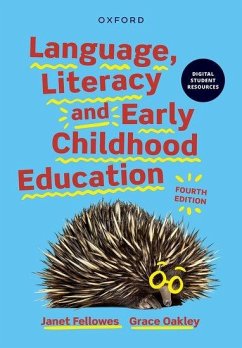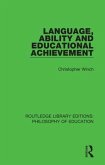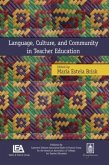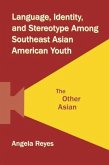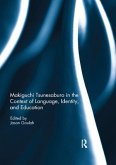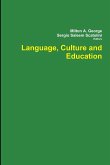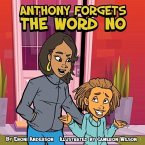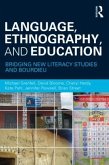- Broschiertes Buch
- Merkliste
- Auf die Merkliste
- Bewerten Bewerten
- Teilen
- Produkt teilen
- Produkterinnerung
- Produkterinnerung
Language, Literacy and Early Childhood Education 4e offers students guidance to understand the nature of oral language, reading and writing, providing the essential knowledge needed to guide the language development and learning needs of young children from birth to eight years old.
Andere Kunden interessierten sich auch für
![Language, Ability and Educational Achievement Language, Ability and Educational Achievement]() Christopher WinchLanguage, Ability and Educational Achievement39,99 €
Christopher WinchLanguage, Ability and Educational Achievement39,99 €![Language, Culture, and Community in Teacher Education Language, Culture, and Community in Teacher Education]() Maria E. Brisk (ed.)Language, Culture, and Community in Teacher Education59,99 €
Maria E. Brisk (ed.)Language, Culture, and Community in Teacher Education59,99 €![Language, Identity, and Stereotype Among Southeast Asian American Youth Language, Identity, and Stereotype Among Southeast Asian American Youth]() Angela ReyesLanguage, Identity, and Stereotype Among Southeast Asian American Youth78,99 €
Angela ReyesLanguage, Identity, and Stereotype Among Southeast Asian American Youth78,99 €![Makiguchi Tsunesaburo in the Context of Language, Identity and Education Makiguchi Tsunesaburo in the Context of Language, Identity and Education]() Makiguchi Tsunesaburo in the Context of Language, Identity and Education67,99 €
Makiguchi Tsunesaburo in the Context of Language, Identity and Education67,99 €![Language, Culture and Education Language, Culture and Education]() Milton A. GeorgeLanguage, Culture and Education21,99 €
Milton A. GeorgeLanguage, Culture and Education21,99 €![Anthony Forgets The Word No Anthony Forgets The Word No]() Eboni AndersonAnthony Forgets The Word No15,99 €
Eboni AndersonAnthony Forgets The Word No15,99 €![Language, Ethnography, and Education Language, Ethnography, and Education]() Michael GrenfellLanguage, Ethnography, and Education78,99 €
Michael GrenfellLanguage, Ethnography, and Education78,99 €-
-
-
Language, Literacy and Early Childhood Education 4e offers students guidance to understand the nature of oral language, reading and writing, providing the essential knowledge needed to guide the language development and learning needs of young children from birth to eight years old.
Hinweis: Dieser Artikel kann nur an eine deutsche Lieferadresse ausgeliefert werden.
Hinweis: Dieser Artikel kann nur an eine deutsche Lieferadresse ausgeliefert werden.
Produktdetails
- Produktdetails
- Verlag: Oxford University Press Australia
- Seitenzahl: 632
- Erscheinungstermin: 14. Dezember 2023
- Englisch
- Abmessung: 255mm x 189mm x 24mm
- Gewicht: 1256g
- ISBN-13: 9780190338770
- ISBN-10: 0190338776
- Artikelnr.: 70601838
- Verlag: Oxford University Press Australia
- Seitenzahl: 632
- Erscheinungstermin: 14. Dezember 2023
- Englisch
- Abmessung: 255mm x 189mm x 24mm
- Gewicht: 1256g
- ISBN-13: 9780190338770
- ISBN-10: 0190338776
- Artikelnr.: 70601838
Janet Fellowes is a consultant in language and literacy education and works with schools and classroom teachers as well as relevant educational organisations. She is currently engaged by the Academic Clinics for Exceptional Students (WA) as a Senior Manager- - Literacy specialist. She was previously a Senior Lecturer at Edith Cowan University where, for many years she taught early childhood and primary teacher education courses for many years. She continues to work with local Western Australian Universities and remains passionate about the quality of their students' learning as language and literacy educators. Grace Oakley is an Associate Professor at the University of Western Australia, specialising in language and literacy pedagogy and practice. She has extensive experience in teaching pre-service teachers and coordinating initial teacher education courses, at both undergraduate and postgraduate levels. She has had classroom experience in K--7 classrooms, including Languages teaching. Grace's research interests and publications focus on the uses of digital technologies in the teaching and learning of language and literacy, inclusive practices and teacher education.
1: Introduction to Literacy: Definitions and Theoretical Perspectives
PART 1: YOUNG CHILDREN, LANGUAGE AND LITERACY
2: Children's Literature
3: Understanding Oral Language
4: Oral Language: Perspectives and Phases
5: Early Childhood Settings and Oral Language Learning and Development
6: Key Early Childhood Learning Contexts for Oral Language
7: Learning Experiences and Activities for Speaking and Listening
8: Language, Thinking and Learning
9: Assessing Speaking and Listening
PART 2: YOUNG CHILDREN AND READING
10: Understanding Reading
11: Phonological Awareness
12: Grapheme Phoneme (Letter-Sound) Knowledge and Word Identification
13: Vocabulary for Reading and Writing
Toolbox of Vocabulary for Reading and Writing
14: Strategies for Teaching Reading
15: Reading for Comprehension
Toolbox of Comprehension Strategies
16: Developing Reading Fluency
Toolbox of Fluency Strategies
PART 3: YOUNG CHILDREN AND WRITING
17: Introduction to Writing
18: Writing Purpose and Text Organisation
19: The Writing Conventions: Grammar and Punctuation
20: Spelling and Handwriting
21: Key Strategies for Teaching Writing
22: Writing Experiences and Activities
23: Assessing and Evaluating Writing
PART 4: FRAMING LANGUAGE AND LITERACY LEARNING
24: Critical Literacy and Visual Literacy
25: Digital Technologies and Literacy
26: Connecting with Families
27: Planning for Language and Literacy
PART 1: YOUNG CHILDREN, LANGUAGE AND LITERACY
2: Children's Literature
3: Understanding Oral Language
4: Oral Language: Perspectives and Phases
5: Early Childhood Settings and Oral Language Learning and Development
6: Key Early Childhood Learning Contexts for Oral Language
7: Learning Experiences and Activities for Speaking and Listening
8: Language, Thinking and Learning
9: Assessing Speaking and Listening
PART 2: YOUNG CHILDREN AND READING
10: Understanding Reading
11: Phonological Awareness
12: Grapheme Phoneme (Letter-Sound) Knowledge and Word Identification
13: Vocabulary for Reading and Writing
Toolbox of Vocabulary for Reading and Writing
14: Strategies for Teaching Reading
15: Reading for Comprehension
Toolbox of Comprehension Strategies
16: Developing Reading Fluency
Toolbox of Fluency Strategies
PART 3: YOUNG CHILDREN AND WRITING
17: Introduction to Writing
18: Writing Purpose and Text Organisation
19: The Writing Conventions: Grammar and Punctuation
20: Spelling and Handwriting
21: Key Strategies for Teaching Writing
22: Writing Experiences and Activities
23: Assessing and Evaluating Writing
PART 4: FRAMING LANGUAGE AND LITERACY LEARNING
24: Critical Literacy and Visual Literacy
25: Digital Technologies and Literacy
26: Connecting with Families
27: Planning for Language and Literacy
1: Introduction to Literacy: Definitions and Theoretical Perspectives
PART 1: YOUNG CHILDREN, LANGUAGE AND LITERACY
2: Children's Literature
3: Understanding Oral Language
4: Oral Language: Perspectives and Phases
5: Early Childhood Settings and Oral Language Learning and Development
6: Key Early Childhood Learning Contexts for Oral Language
7: Learning Experiences and Activities for Speaking and Listening
8: Language, Thinking and Learning
9: Assessing Speaking and Listening
PART 2: YOUNG CHILDREN AND READING
10: Understanding Reading
11: Phonological Awareness
12: Grapheme Phoneme (Letter-Sound) Knowledge and Word Identification
13: Vocabulary for Reading and Writing
Toolbox of Vocabulary for Reading and Writing
14: Strategies for Teaching Reading
15: Reading for Comprehension
Toolbox of Comprehension Strategies
16: Developing Reading Fluency
Toolbox of Fluency Strategies
PART 3: YOUNG CHILDREN AND WRITING
17: Introduction to Writing
18: Writing Purpose and Text Organisation
19: The Writing Conventions: Grammar and Punctuation
20: Spelling and Handwriting
21: Key Strategies for Teaching Writing
22: Writing Experiences and Activities
23: Assessing and Evaluating Writing
PART 4: FRAMING LANGUAGE AND LITERACY LEARNING
24: Critical Literacy and Visual Literacy
25: Digital Technologies and Literacy
26: Connecting with Families
27: Planning for Language and Literacy
PART 1: YOUNG CHILDREN, LANGUAGE AND LITERACY
2: Children's Literature
3: Understanding Oral Language
4: Oral Language: Perspectives and Phases
5: Early Childhood Settings and Oral Language Learning and Development
6: Key Early Childhood Learning Contexts for Oral Language
7: Learning Experiences and Activities for Speaking and Listening
8: Language, Thinking and Learning
9: Assessing Speaking and Listening
PART 2: YOUNG CHILDREN AND READING
10: Understanding Reading
11: Phonological Awareness
12: Grapheme Phoneme (Letter-Sound) Knowledge and Word Identification
13: Vocabulary for Reading and Writing
Toolbox of Vocabulary for Reading and Writing
14: Strategies for Teaching Reading
15: Reading for Comprehension
Toolbox of Comprehension Strategies
16: Developing Reading Fluency
Toolbox of Fluency Strategies
PART 3: YOUNG CHILDREN AND WRITING
17: Introduction to Writing
18: Writing Purpose and Text Organisation
19: The Writing Conventions: Grammar and Punctuation
20: Spelling and Handwriting
21: Key Strategies for Teaching Writing
22: Writing Experiences and Activities
23: Assessing and Evaluating Writing
PART 4: FRAMING LANGUAGE AND LITERACY LEARNING
24: Critical Literacy and Visual Literacy
25: Digital Technologies and Literacy
26: Connecting with Families
27: Planning for Language and Literacy
